MXA RACE TEST: THE REAL TEST OF THE 2025 TM 125MX TWO-STROKE
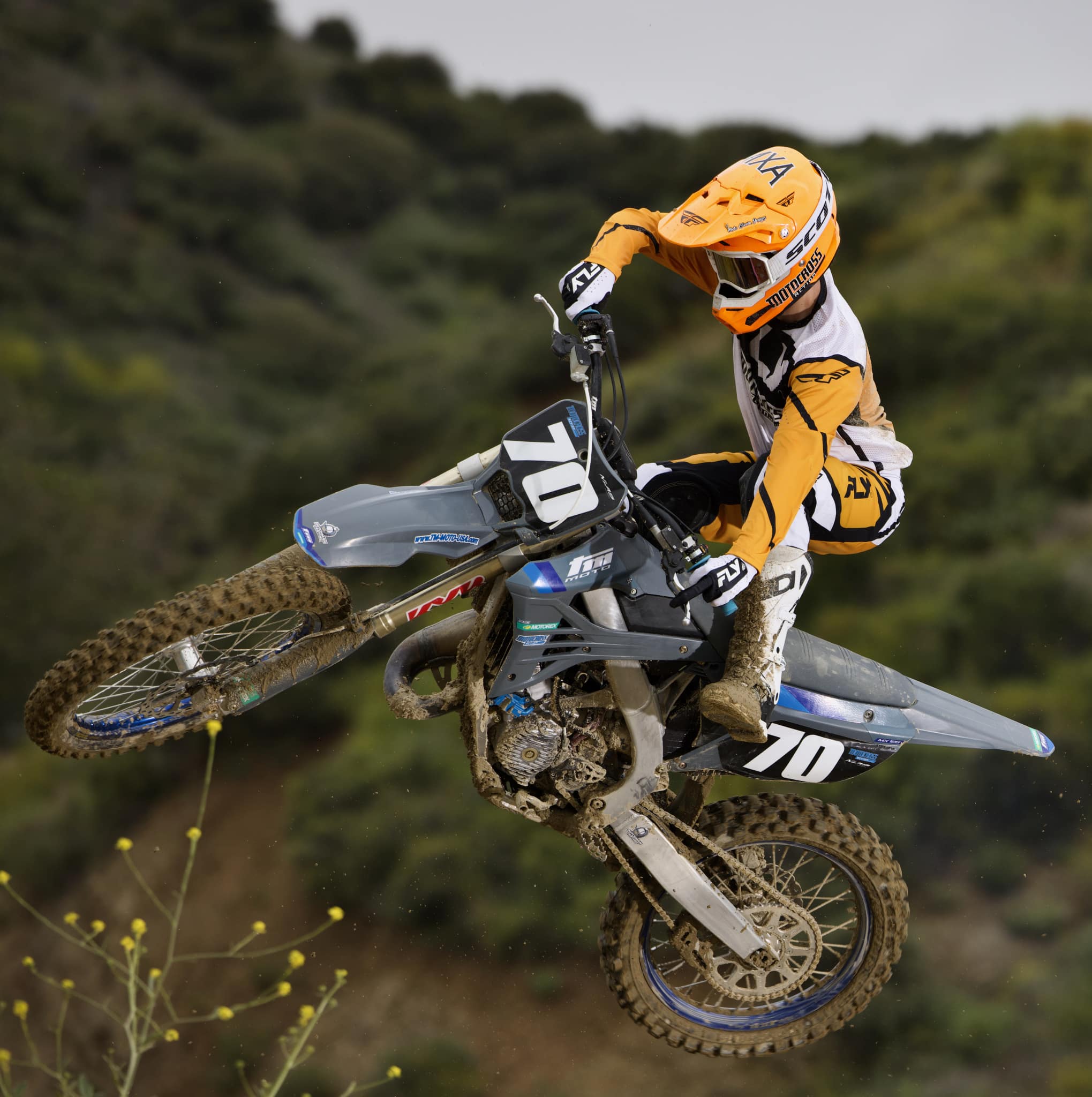 THE GEAR: Jersey: Fly Racing Lite, Pants: Fly Racing Lite, Helmet: Fly Racing Formula, Goggles: Scott Prospect, Boots: Sidi Crossair.
THE GEAR: Jersey: Fly Racing Lite, Pants: Fly Racing Lite, Helmet: Fly Racing Formula, Goggles: Scott Prospect, Boots: Sidi Crossair.
Q: FIRST AND FOREMOST, IS THE 2025 TM 125MX BETTER THAN THE 2024 MODEL?
A: An excellent question that we are unable to answer because MXA’s prestigious bike barn has been missing the exotic Italian TM motorcycles for the last few years. When TM’s previous importer Ralf Schmidt parted ways with TM, the pipeline from Italy stopped flowing. Recently, Cam Mitchell of 71 Powersports and the Canadian TM importer decided to expand into the U.S., leveraging much of the same TM dealership network that previously worked with Ralf. And, voila! TMs are here to ride again.
Q: WHAT’S NEW ON THE 2025 TM 125MX?
A: According to TM, the 125 has a newly designed, ECVS-patented, SBS exhaust valve engine with an electric starter motor. We translated this to mean the new engine is paired to a new ECU with optimized mapping to make the magic happen. Incoming air flows through a redesigned air filter boot and updated exhaust from fellow Italian manufacturer Scalvini. A new regulator handles the extra functions of the starter motor, electric power valve and optional fuel injection. New radiators keep things cool, and a new engine guard protects vital bits. It appears that the TM crew has been busy with this motorcycle.
Q: WHERE DOES THE TM 125MX FIT INTO TM’S MODEL LINEUP?
A: TM offers its 125 in two different versions, either carbureted or fuel-injected, for three separate disciplines: MX (moto), EN (enduro), or SMD (Supermoto). Because TM is a small boutique brand producing a limited number of bikes each year, the consumer has many options to choose from. You can have a kickstand or not. You can order a bike directly from the factory with A-kit suspension, billet parts, or a different shock linkage. You can choose different triple clamps and other features as well. This customization is a very cool perk of choosing a TM motorcycle. But, you will have to pay for it. The TM 125MX, as tested, has an MSRP of $9495.
Q: HOW DID THE 2025 TM 125MX RUN ON THE DYNO?
A: We compared the TM 125MX to the 2025 Yamaha YZ125 and the 2025 Husky TC125 on the dyno. On peak numbers, they landed pretty close. The TM is faster and stronger than the Yamaha, but it slots in underneath the Husky. The YZ125 peaks at 35.78 horsepower with 16.47 pound-feet of torque. The TM 125MX hits 36.19 horsepower with 17.10 on the torque scale, and the Husky hits 36.86 horsepower with 16.99 pound-feet of torque.
The numbers are all close, but how they get there varies. The Yamaha YZ125 has a hit of power at 7500 rpm, but then it drops off and sits about 2 horsepower below the competition until the Husky and TM start to peter off in the 11,000-rpm range. The TM 125MX follows the Husky TC125’s power curve closely and actually edges out the Husky just barely in a few areas, but it peaks just below the Austrian bike.
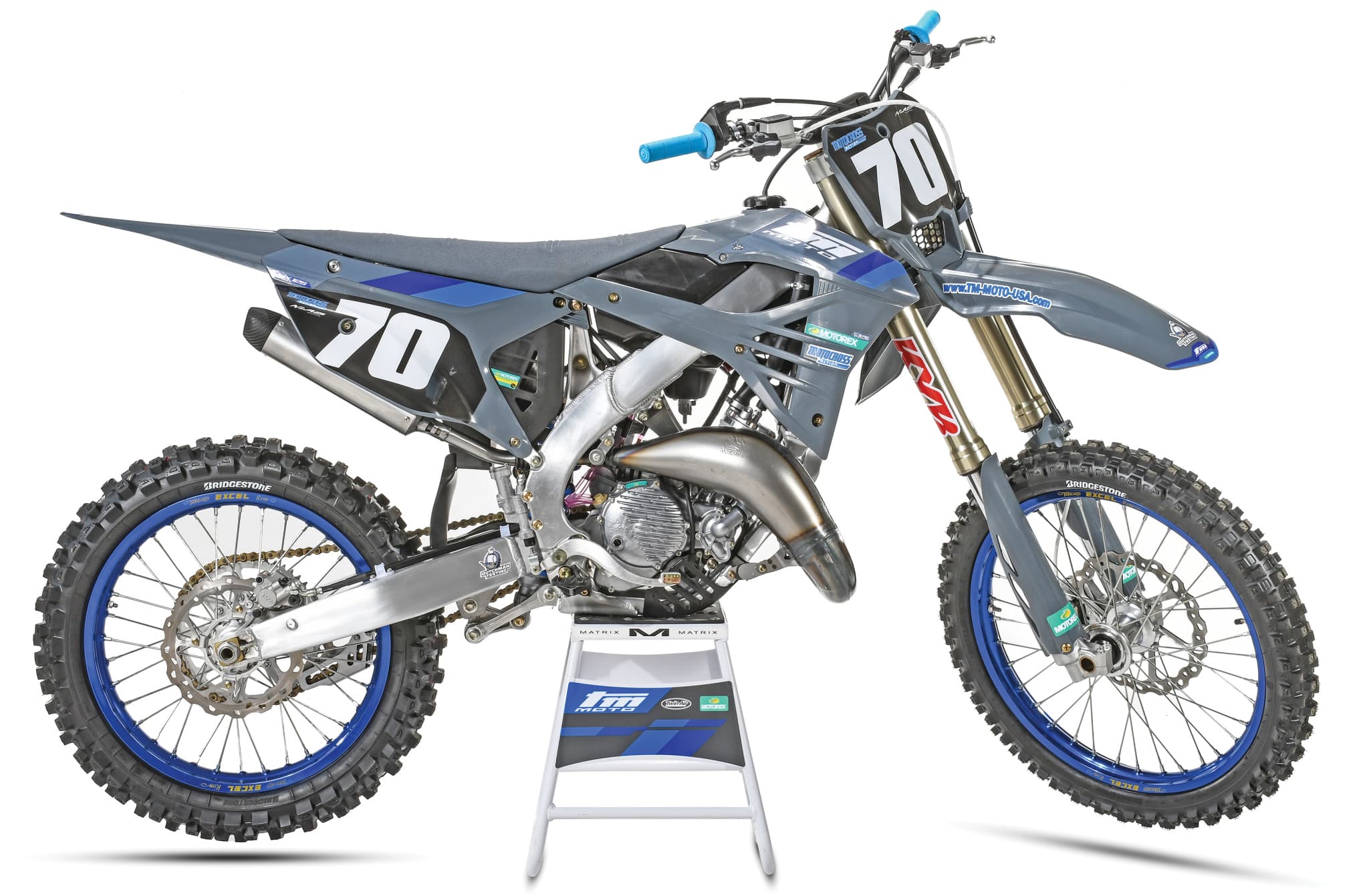 The TM 125MX is new for 2025 with an updated engine and a new electronic power valve.
The TM 125MX is new for 2025 with an updated engine and a new electronic power valve.
Q: HOW DOES THE 2025 TM 125MX RUN ON THE TRACK?
A: The first and possibly most important thing you will notice about the TM 125MX is the sound. The exhaust note is precious. TM two-strokes are some of the best-sounding machines in stock trim. The power delivery is very strong and also very narrow. Like classic 125 machines from yesteryear, the narrow powerband requires finesse and accuracy, but unlike older-generation 125s, the TM 125 is powerful—every bit as powerful as other modern 125s on the market. Peak horsepower is excellent, but the power delivery isn’t as effective at lowering lap times because few riders can keep the engine in its sweet spot at all times. Maybe if the transmission had eight gears to make smaller gearing changes possible. Or, maybe a wizard’s wand to apply the clutch in some fantastic way so as to always match engine rpm, wheel speed, and perfect throttle control.
Even though the dyno curve looks nice, the seat-of-the-pants test proves that the TM is harder to keep in the meat of the power than the Yamaha and the Husky. The dyno tests an engine when it’s wide open with variables limited to air-quality factors, such as temperature and humidity on that given day, while track testing exposes every weakness. The TM engine has potential, but it takes skill to keep it in the sweet spot.
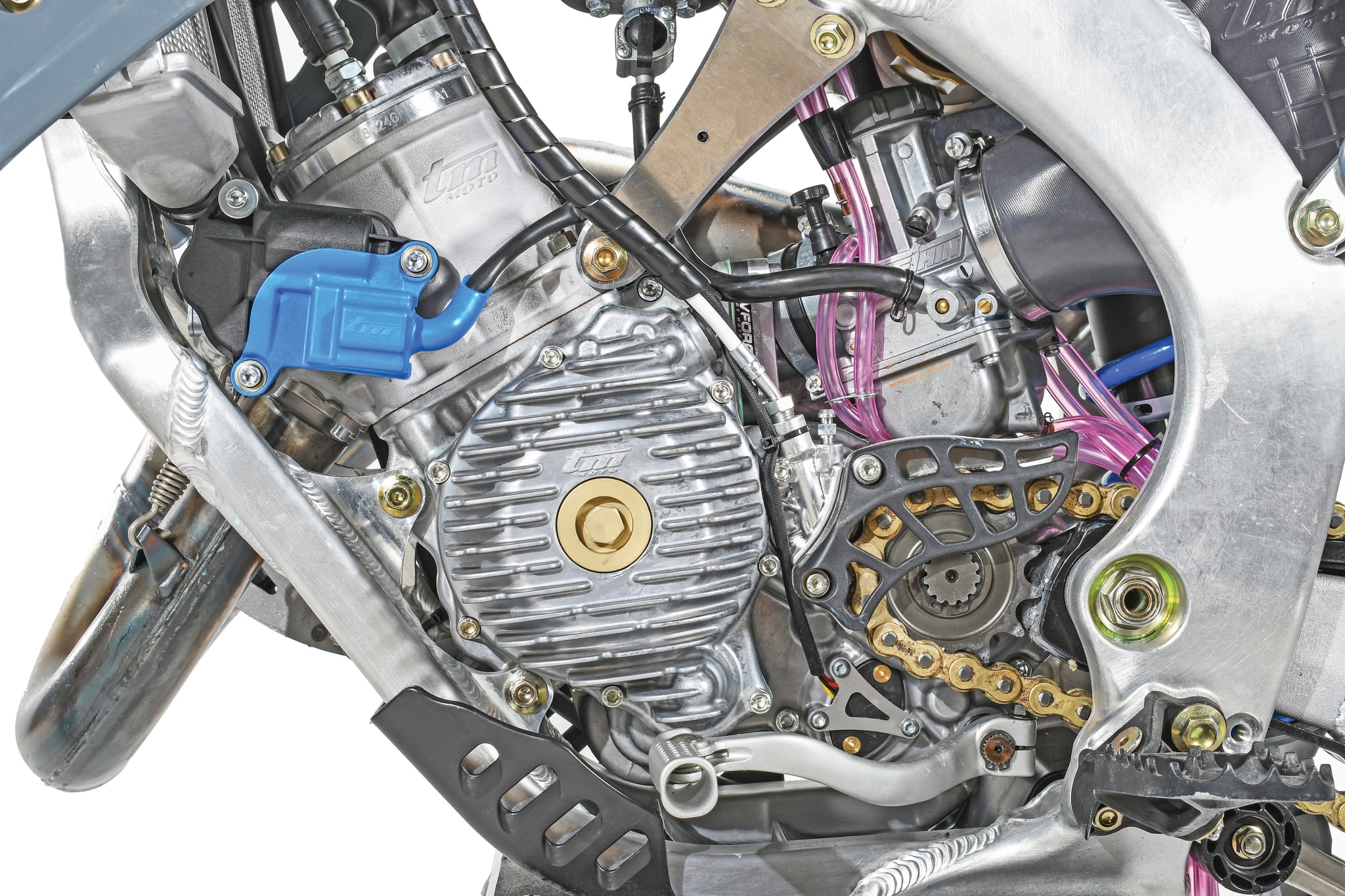
Q: WHAT CHANGES DID WE MAKE TO THE 2025 TM 125MX ENGINE?
A: While breaking in the TM 125MX, we experienced a massive bog, and it was almost unrideable. With help from TM’s previous importer Ralf Schmidt, we dug deep into our two-stroke bag o’ tricks and went to work. We first leaned out the carburetor pilot jet from the stock size 50 all the way down to a size 40. Next, we changed the needle to a NOZG (NOZE is stock). The leaner pilot and leaner needle gave the engine the necessary throttle response, but now the main jet needed to be richened. So, the 188 main became a 192, and then we had a runner.
Q: HOW DOES THE 2025 TM 125 MX HANDLE?
A: The TM handles well with good balance between the front and rear suspension. It is happy to carve the innermost line or rail a berm. If you want to pivot and shoot across to the other side of the track, no problem. The bike is stable and predictable.
The forks transfer a lot of feedback from the ground into the rider’s hands. After the first few warm-up laps around the track, we pulled in and checked the front forks for any kind of mechanical interference. We loosened and re-torqued the triple-clamp bolts (after a scavenger hunt through the pits to find Allen tools for our torque wrench). After ensuring the front axle and fork alignment were correct, we grabbed a screwdriver and headed back out on the track. By the end of a few long motos, our test riders’ hands felt as if their palms were bruised and battered. Fortunately, the Kayaba forks are very familiar to most suspension shops and should be easy to improve with the help of a good tuner.
The shock is an in-house TM shock and works well. The clickers are very effective and offer a large range of adjustability. Our test riders each found a setting that would accommodate them, but the shock spring had major interference with the shock body and rubbed badly, causing a lot of friction. So much, in fact, that TM designed a phenolic bushing onto the shock body to lessen the wear on the aluminum. One constant in regards to suspension performance is that friction is bad.
Q: HOW DOES THE 2025 TM 125MX COMPARE TO THE CURRENT 125s ON THE MARKET?
A: The market for new 125 motocross bikes here in the U.S. is currently limited to Yamaha, KTM, GasGas and Husqvarna. Because three of these are more alike than different, we are really comparing the TM 125MX to two different bikes. The Yamaha is carbureted, and the Austrian bikes are fuel-injected. The YZ has a traditional kick-start, a traditional power-valve mechanism, and a mechanical spring fork, while the Austrian bikes are electric starting with electronically controlled power valves, and they’re equipped with WP air forks. The TM we tested split the difference by having an electric starter and power valve, along with a carburetor and KYB spring forks.
(1) Ergos. Our first impression was that the TM 125MX is comfortable to sit on and ride. Everything feels like it’s in the correct place. The handlebars are on the narrower and lower side of the spectrum, and the flat seat makes the bike feel longer. The distance between the shifter and footpeg is similar to that on the Japanese bike and slightly shorter than on the KTM, GasGas, and Husqvarna bikes.
(2) Power. The power is strong but difficult to use. If you can nail your shift points perfectly, you might outrun all the bikes to the first turn. Having a carburetor provides the opportunity to fine-tune jetting to ambient conditions. But having the electronically controlled power valve throws a curveball into the plans of tuners. Yes, the carburetor can be jetted for ambient conditions and different fuels, but can the power valve be adjusted? Is the ECU fluent in Italian only? Tuners already know that with the new fuel-injected and ECU-controlled power-valve Austrian bikes, aftermarket modifications are difficult and less effective than on carbureted two-strokes.
(3) Handling. As stated previously, the handling is okay. The TM 125MX feels light and nimble—as a 125 should feel. The shock tracks well and doesn’t do anything terrible. The forks are harsh-feeling in the riders’ hands but absorb big bumps without bottoming. At race pace, the bike gives the impression that it might get squirrely at any moment, but it never does. The couple of times it got buck wild down Glen Helen’s extremely rough, world-famous downhill during the recent MotoFest, the bike was never fully out of control. It handled the scary moments with panache.
(4) Maintenance. Our time with the TM 125MX only required regular maintenance. Changing the filter is old school, requiring tools to remove the seat bolts (yes, Allen bolts) and the seat. But, the air filter itself clips in with nice modern-style plastic pins and grommets. The angle of the large air filter element is precisely the angle to knock dirt off a dirty filter and down into the air boot. You must clean the boot of debris before installing a fresh air filter.
Transmission oil service, chain adjustment, spoke tension, etc., are all straightforward and normal procedures. The biggest challenge was finding a current workshop manual to reference for torque specs and capacities.
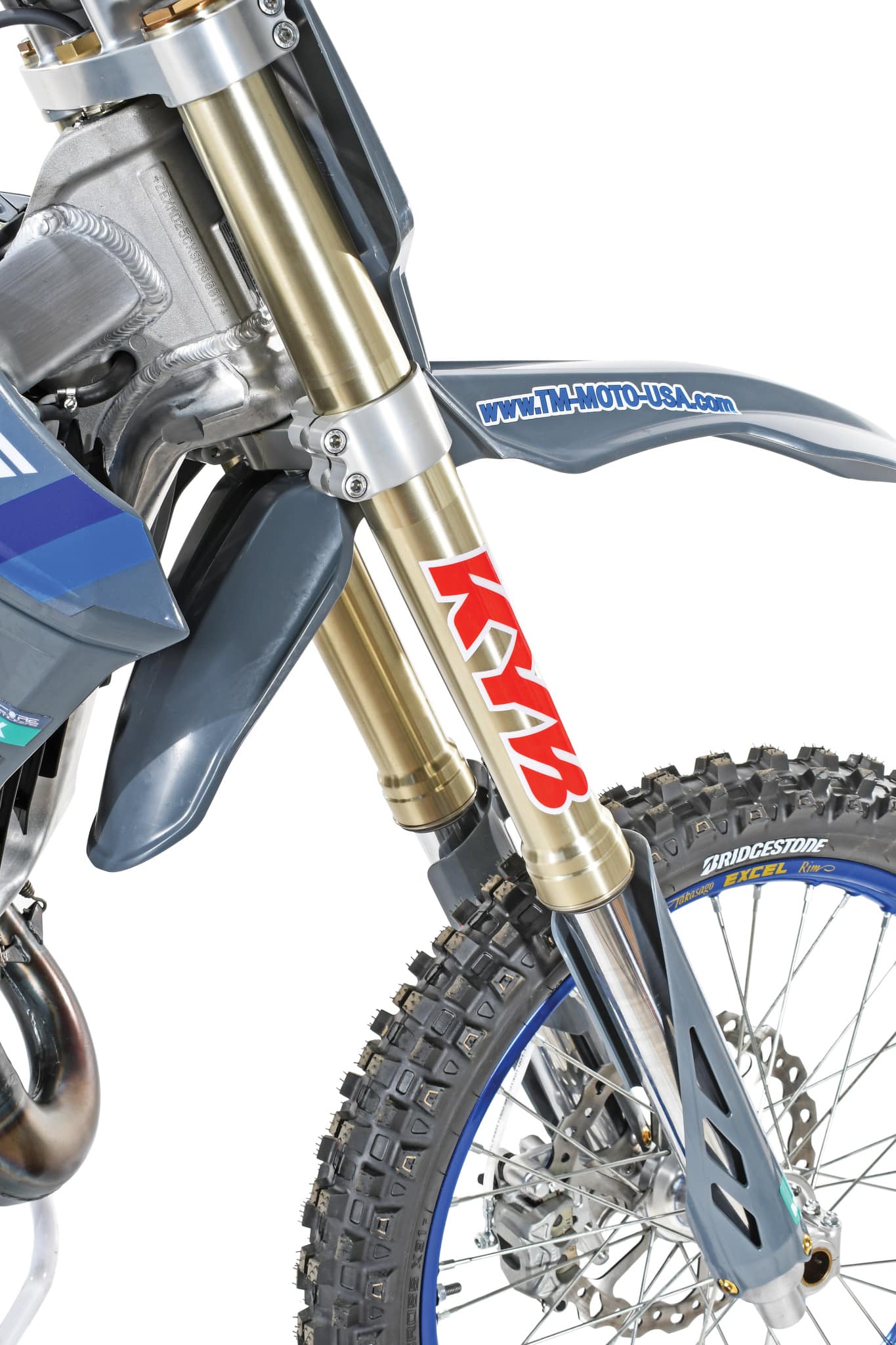 The 125MX comes with KYB forks and a TM shock. The forks are stiff!
The 125MX comes with KYB forks and a TM shock. The forks are stiff!
Q: WHAT DID WE HATE?
A: Here’s our hate, er, “this could be better” list.
(1) Tires. The Bridgestone Battlecross X31 tires definitely kept our test riders battling cross-ups in the corners. Trying to go fast with these tires is like unknowingly lacing up your kid’s Heelys shoes and heading out to the pickleball court; it ends badly.
(2) Grips. The soft baby blue color, though attractive and gentle on the eyes, is misleading. These grips are about as hard as the handlebars themselves.
(3) Hardware. TM predominantly uses socket-head cap screws requiring Allen keys to manipulate the fasteners. Good advice when purchasing Allen keys is to spend money on the higher-quality brands and save your sanity. Allen-head fasteners and tools wear quickly and become damaged easily relative to standard hex-head bolts.
(4) Rev limiter. TM is not messing around with the rev limiter on the engine. If it has any indication whatsoever of an over-rev condition, the rev limiter is fully engaged. We are talking even under a full-throttle clutch upshift. And once the rev limiter is deployed, it takes a moment for the bike to regroup and go again. It’s a strange sensation at first, almost as if you just jiggled the tilt sensor on the pinball machine and it yelled a warning at you. With time, you adjust to this quirk and can easily ride around it and learn the shift points. When you do, the power is great. Try to force the TM 125MX to be like a different bike and it won’t work well.
(5) E-start. We didn’t complain about the electric starter on the 2025 TM 300MX because the 300cc engine takes more effort to kick over, but the e-starter feels like overkill on a 125cc two-stroke.
(6) Brake pedal. The rear brake pedal is not sleek. Our testers accidentally stood on the beginning portion of the lever where it bends up multiple times.
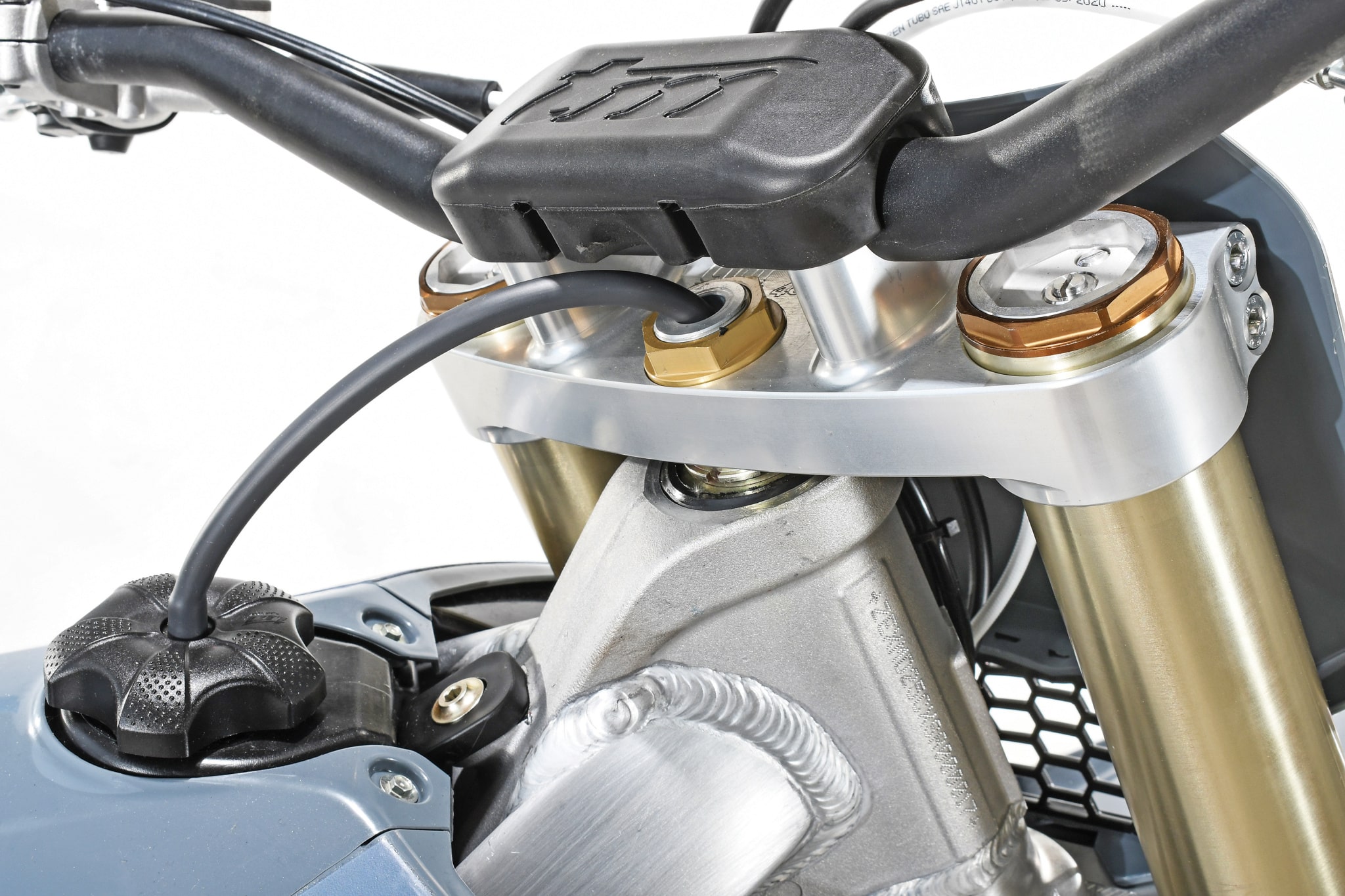 You can choose solid mounts or rubber handlebar mounts when ordering your bike from TM.
You can choose solid mounts or rubber handlebar mounts when ordering your bike from TM.
Q: WHAT DID WE LIKE?
A: There’s much to like here.
(1) Engine. The sound and peak power. The TM 125MX sounds perfect and has power. Are you good enough to utilize it? That’s another question.
(2) Styling. The TM 125MX is a good-looking motorcycle. The gray plastic and blue graphics go well together but age rapidly. Within 15 hours, the plastic shows white crease lines and the graphics are gone. The rear fender is starting to twist from being used to pick up the bike and put it on the stand. But, if you hit the plastic with a quick heat-gun treatment, it freshens up a bit. The extra casting on both the stator and clutch cover actually keeps the covers looking new, as no scratches show up. This is a sneaky aesthetic design feature masked as a performance part. Creative. And, standard gray duct tape matches almost perfectly to make quick, camouflaged plastic repairs.
(3) Quality. Brembo front brake and hydraulic clutch. Nissin rear brake. Excel wheels. V-Force reed valve. A bunch of extra sprocket bolts. Simple, classic, individual, push-button starters and kill switches that have proven to work for decades. TM paid attention to little details in the wire harness and hydraulic hose routing, including a nicely wrapped and finished protective casing.
(4) Options. Purchasing an exotic, hand-built Italian motocross bike gives you options. When you order it, you are now among a small group of owners, and you can select some different options for your bike. This is a neat concept, and if it could be scaled, it might change the market. But therein lies the problem. It takes time to get your bike. You can’t roll down to the local TM dealer, pick one up and race it this weekend. Delivery after ordering takes a few weeks. But, it’s the same when you go to buy your Ferrari, Lamborghini or Maserati. They might not have the one you want on the showroom floor.
(5) Weight. At 203 pounds (without fuel in the tank, but all other fluids included), the TM 125MX is 4 pounds heavier than the Yamaha YZ125 and 1-1/2 pounds lighter than the KTM 125SX. This isn’t bad for a 125 with an electric starter.
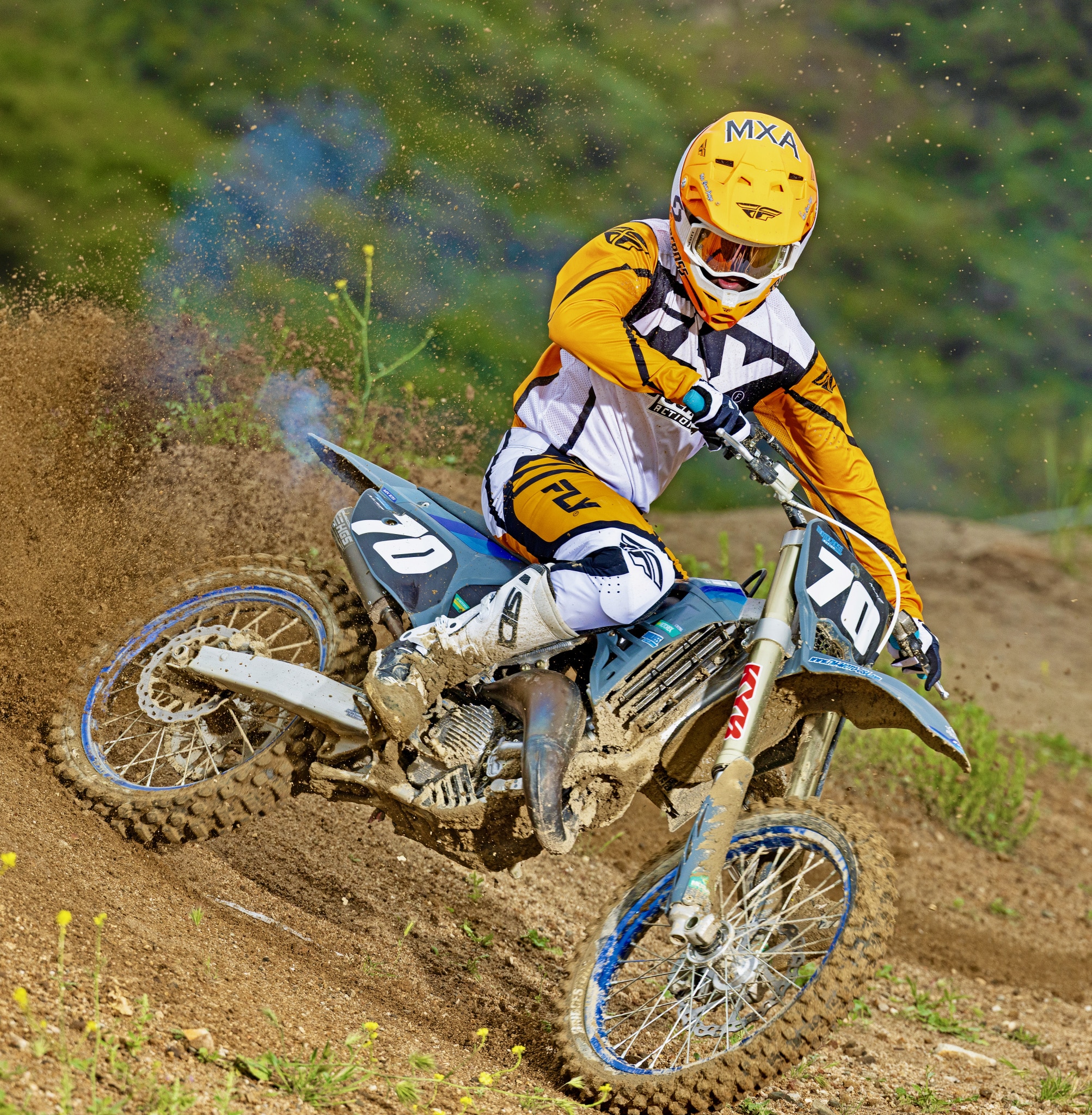 The TM 125MX is fast, but it takes skill to keep it within the power window.
The TM 125MX is fast, but it takes skill to keep it within the power window.
Q: WHAT DID WE REALLY THINK?
A: The more time we spend on the TM 125MX, the more we like the engine and the more we want the suspension to be better. As lap times drop and bumps get larger, the suspension holds the bike back. We know the Kayaba forks can be superb with proper setup, but we have less experience with the TM shock. We are confident there is a suspension tuner around with TM shock experience. We just aren’t sure who it is.
There’s some value in being different or having something very few others have. When you roll up to the starting line on the TM 125MX, people notice. When the bike is speeding around the track, people notice. It’s akin to driving into a parking lot in any iconic Italian sports car. Everyone thinks you have a powerful engine, exotic styling, a sleek and elegant design, a luxurious garage, and a race rig, but nobody really knows how you are going to perform.


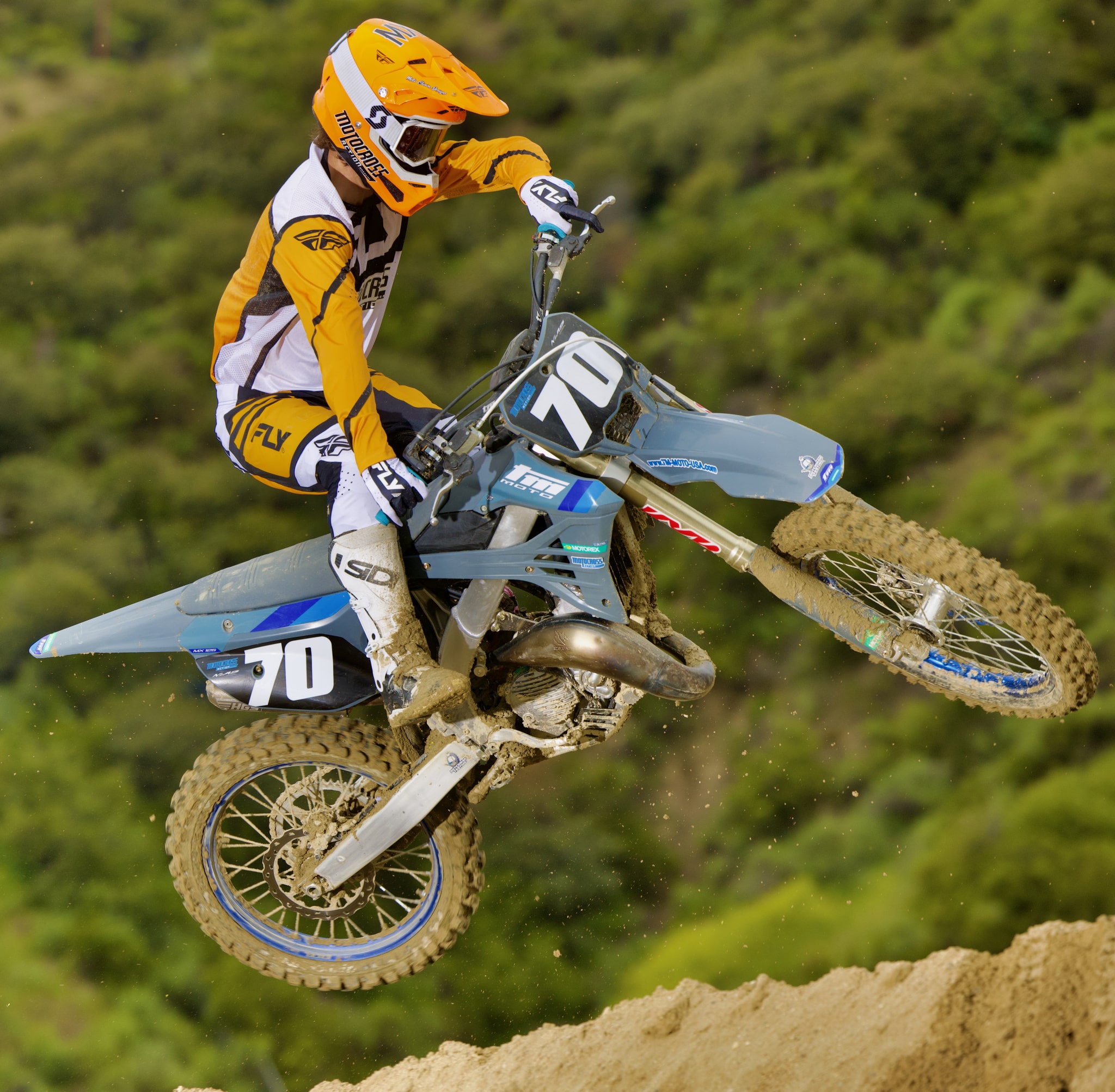

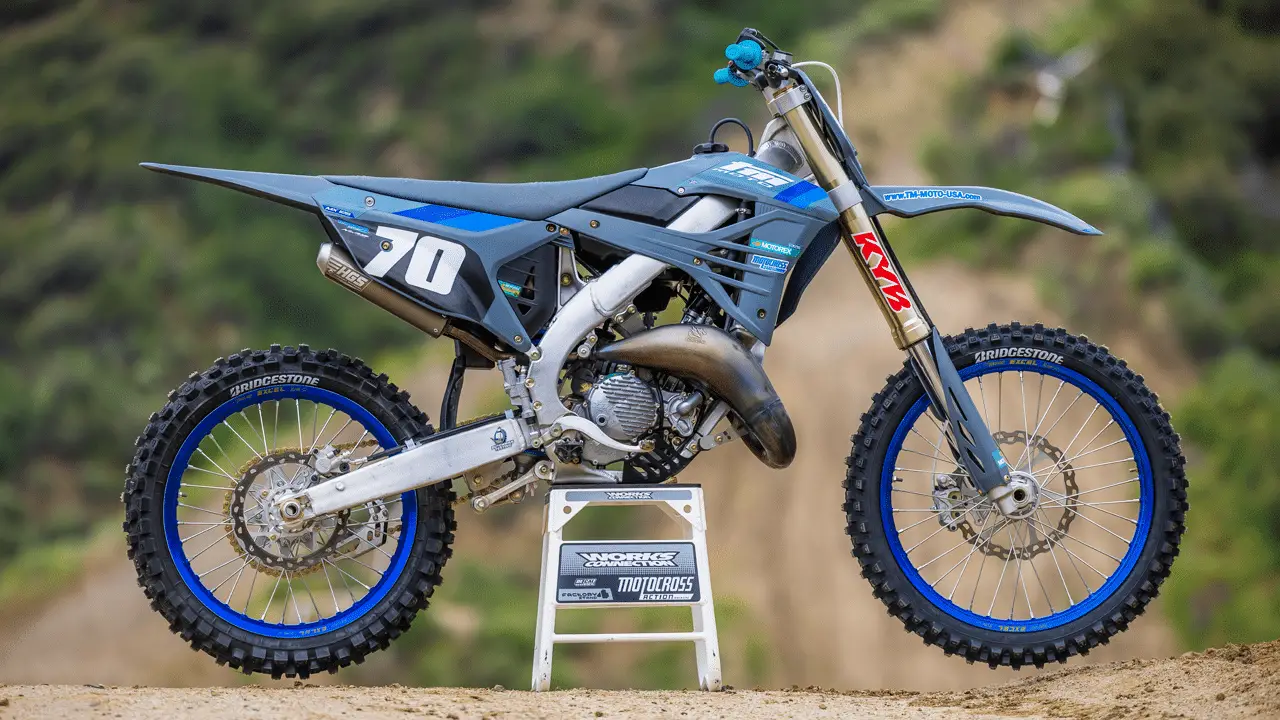
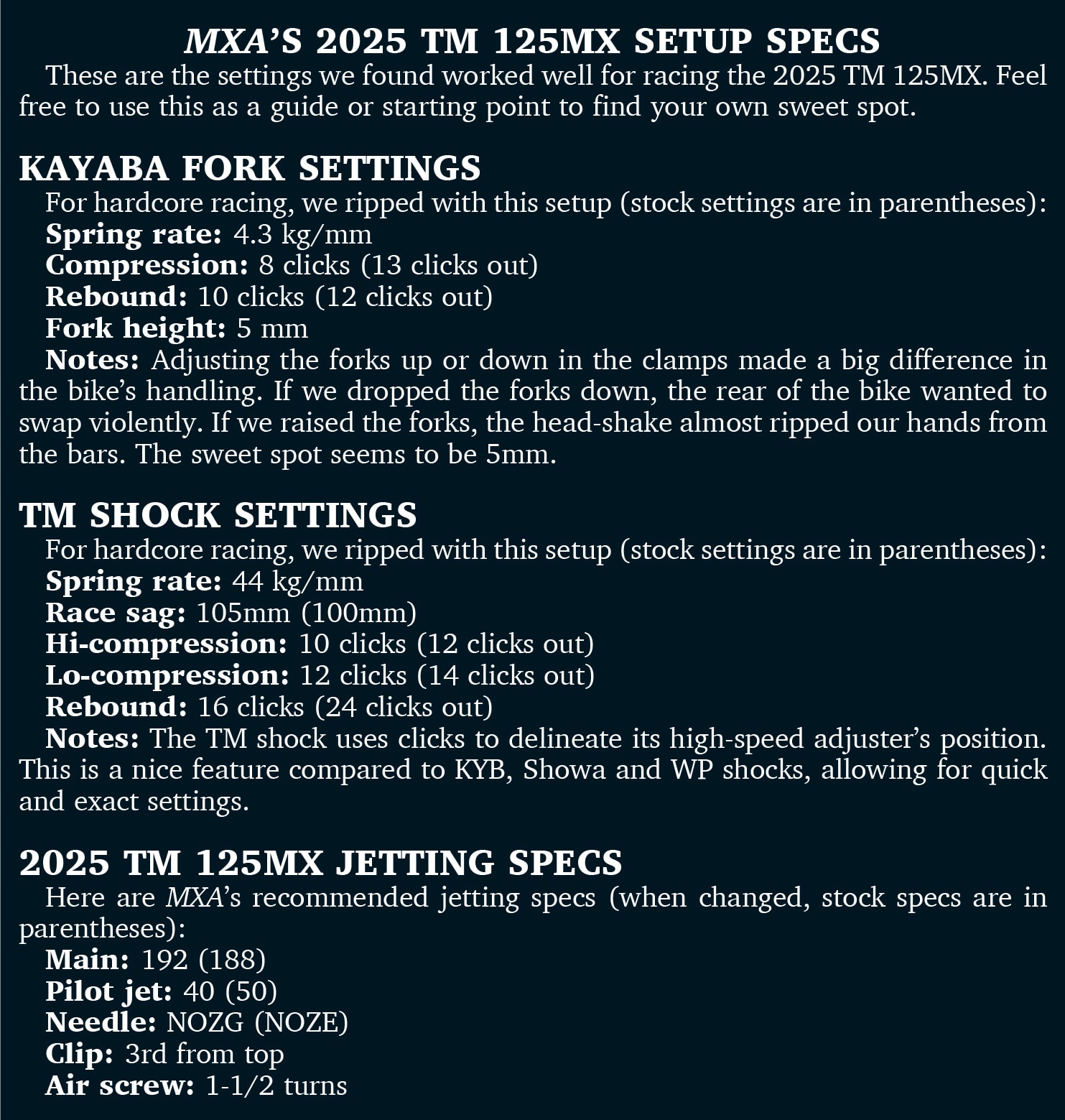

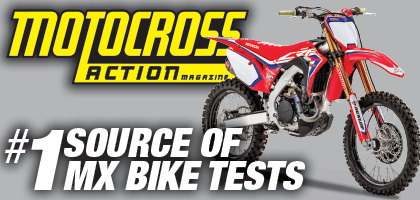

Comments are closed.